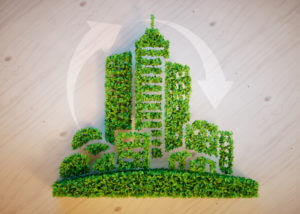 Interest in sustainable, green building practices is greater than ever. Whether concerned about boosting occupant health, cutting energy costs, increasing durability and long-term value, owners are looking for ways to ensure that their buildings are healthy, safe, efficient and beautiful.
Interest in sustainable, green building practices is greater than ever. Whether concerned about boosting occupant health, cutting energy costs, increasing durability and long-term value, owners are looking for ways to ensure that their buildings are healthy, safe, efficient and beautiful.
All buildings use resources (energy, water, raw materials, etc.), generate waste (construction, occupant, and demolition), and emit potentially harmful atmospheric emissions. Building owners and builders face a unique challenge to meet these increasing demands for new or renovated facilities that are accessible, secure, healthy and productive while minimizing any negative impacts on the environment.
6 Fundamental Principles of Sustainable Building Design
The Whole Building Design Guide Sustainable Committee, a program of the National Institute of Building Sciences, offers a robust portal providing up-to-date information on a variety of building-related information from a ‘whole building perspective.’ While the definition of sustainable building design is constantly evolving, they define six fundamental principles that remain steady.
1. Optimize Site Potential
Whether designing for a new building or retrofitting an existing structure, site designs must integrate with specific sustainable goals to achieve a successful project. The location, orientation and landscaping of a building all affect local ecosystems, transportation methods and energy usage; it’s important to incorporate smart growth principles into the project development plans.
2. Improve Energy Usage
Improving the energy performance of new and existing buildings is important to increasing our energy independence. One way to offset consumption is by using net-zero energy building designs. As defined by the Department of Energy, a net-zero energy building is “an energy-efficient building where, on a source energy basis, the actual annual delivered energy is less than or equal to the on-site renewable exported energy.”
3. Conserve Water and Embrace Other Green Building Practices
As an increasingly scarce resource, fresh water use is important. The use, reuse or recycling of fresh water should be done on-site when feasible. Other ways to ensure green building practices is by achieving a LEED certification. LEED provides independent verification of a building’s green features throughout a building’s life-cycle. These include planning to design, construction, operation, maintenance, renovation, and demolition.
4. Use Sustainable Building Materials
Designed and operated to use and reuse materials in the most productive way across their life-cycle, sustainable buildings achieve an integrated use of materials that maximize their value and conserve resources. Sustainable building materials minimize consumption of energy and resources and maximize the use of natural, recycled and non-toxic materials. These environmentally preferable materials will have a positive effect on both occupant health and the environment.
5. Enhance Indoor Environmental Quality
The indoor environmental quality (IEQ) of a building has a substantial impact on occupant productivity, comfort and health. One way buildings can optimize IEQ is by achieving the WELL Building Standard Certification. WELL is a holistic, performance-based building standard designed to create healthy indoor spaces across seven categories of building performance and human impact including: air, water, nourishment, light, fitness, comfort and mind.
6. Optimize Operational and Maintenance Practices
Optimized buildings result in lower energy costs, lower carbon emissions and greater occupant thermal and visual comfort. But to ensure optimal operations and maintenance of a building, considerations must be made during the preliminary design phase.
Meeting Demands for Sustainable Building Materials
From using sustainable building materials for new construction to retrofitting an existing building with sustainable design attributes, at KMB, we seek to balance out the needs of each of these areas by using an integrated approach with a design solutions tailored for each client’s specific needs.
As a full-service engineering solutions provider licensed in the United States and Europe, we take a systematic approach to develop comprehensive engineering solutions and understand the specific energy-conserving measures incorporated into sustainable building designs to ensure the most economically sound alternatives are presented.
Contact us to learn more about incorporating green building practices into your next project!